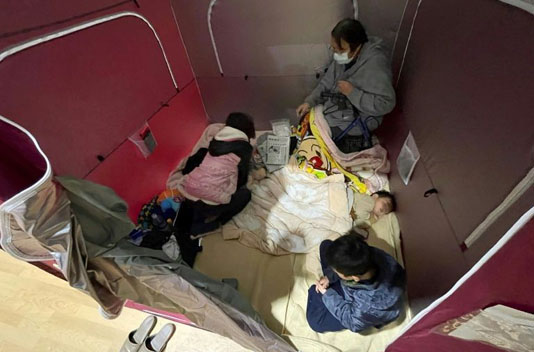TOKYO, Feb 14, 2021 (BSS/AFP) – A 7.3-magnitude earthquake off Japan’s
Fukushima injured dozens of people, authorities said Sunday, nearly 10 years
after the eastern region was hit by a huge quake that sparked a tsunami and
nuclear meltdown.
Prime Minister Yoshihide Suga said no casualties had so far been reported
after the late-night quake, which did not trigger a tsunami warning.
“We have received reports of many injuries in the Fukushima and Miyagi
regions. But so far we have not received any reports of deaths,” he told an
emergency cabinet meeting on Sunday morning.
The disaster agency said 74 injuries had been reported in the region and
also around Tokyo, where the quake was felt strongly just after 11 pm on
Saturday.
But local media counted at least 104 reported injuries, from broken bones
to cuts from shattered glass.
No abnormalities were reported at the Fukushima nuclear plant, which
melted down in the wake of the March 2011 quake that triggered a towering
tsunami and killed more than 18,000 people.
Japan’s meteorological agency said Saturday’s quake, which hit at a depth
of 60 kilometres (37 miles) in the Pacific off Fukushima, was considered an
aftershock of the massive tremor nearly a decade ago.
“I was at home. I cannot even remember whether it was horizontal or
vertical shaking. But it felt like it lasted for 30 seconds,” Masami Nakai, a
municipal official in Soma city in northern Fukushima, told AFP about
Saturday’s quake.
“The shaking was so strong I became truly afraid of my physical safety,”
he said.
No significant damage was reported but authorities were assessing the
impact of a landslide on a highway, government spokesman Katsunobu Kato said,
while aerial TV footage showed another landslide at a remote race circuit.
Kato warned residents about the possibility of strong aftershocks in the
next week and further landslides due to heavy rain forecast.
“Particularly for the next two to three days, there might be very strong
earthquakes,” Kato said.
– Emergency shelters –
Water outages were affecting 4,800 households, Kato said, adding that
health ministry staff and self-defense troops were heading to affected areas
to deliver water.
Around 950,000 homes lost power throughout the region, but electricity had
been restored in most areas by Sunday morning, according to a regional
utility.
Kato said as of early Sunday more than 250 people were at 173 emergency
shelters in Fukushima and surrounding regions, where social distancing
measures have been put in place. Many may have since returned home, he added.
Pfizer, whose coronavirus vaccine is set to become the first to be
approved in Japan later Sunday, has told the government that the quake did
not affect facilities storing the jabs, Kato said.
Images posted online showed broken glass at a shop and items spilled off
the shelves at a supermarket.
Tomoko Kobayashi, who works at a traditional inn in Fukushima’s Minamisoma
city, told Kyodo news agency that “the initial jolt felt more powerful than
the one I experienced in the Great East Japan Earthquake” of 2011.
Renowned author Yu Miri, who also lives in Minamisoma, tweeted a photo of
her home, showing books, potted plants and other belongings strewn across the
floor.
“My house in Odaka, Minamisoma city is all messed up,” she wrote.
“I hear the ground rumbling. And another quake,” she tweeted about an
aftershock.
The US Geological Survey registered the quake at a revised magnitude of
7.1 with a depth of 51 kilometres.
Japan sits on the Pacific “Ring of Fire”, an arc of intense seismic
activity that stretches through Southeast Asia and across the Pacific basin.
The country is regularly hit by quakes, and has strict construction
regulations intended to ensure buildings can withstand strong tremors.
In September 2018, a powerful 6.6-magnitude quake rocked Hokkaido,
triggering landslides, collapsing houses and killing more than 40 people.



